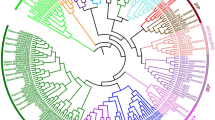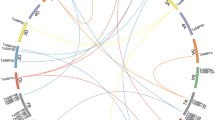Abstract
MADS-box genes form a large family of transcription factors and play important roles in flower development and organ differentiation in plants. In this study, 42 wheat cDNAs encoding putative MADS-box genes were isolated. BLASTX searches and phylogenetic analysis indicated that the cDNAs represented 12 of the 14 MADS-box gene subfamilies. TaAGL14 and TaAGL15 formed a new subfamily along with a rice gene OsMADS32. RT-PCR analysis revealed that these genes had different exprsssion patterns in different organs of different stages. Expression patterns of TaAGL1 and TaAGL29 were also determined using in situ hybridization. TaAGL1 was abundantly expressed in primary root tips and the whole spikelet with more intense labeling at lodicules, paleas and stamens. TaAGL29 was expressed in both the non-reproductive parts (lemma, palea and glumes), and stamens and pistils. Moreover, differential expression patterns of these genes were also observed between wheat hybrid and its parents in leaf, stem and root of jointing stage, some were up-regulated while others were down-regulated in hybrid as compared to its parents. We concluded that multiple MADS-box genes exist in wheat genome and are expressed in tissue-specific patterns, and might play important roles in wheat growth and development.








Similar content being viewed by others
References
Alvarez-Buylla ER, Liljegren SJ, Pelaz S, Gold SE, Burgeff C, Ditta GS, Vergara-Silva F, Yanofsky MF (2000a) MADS-box gene evolution beyond flowers: expression in pollen, endosperm, guard cells, roots and trichomes. Plant J 24:457–466
Alvarez-Buylla ER, Liljegren SJ, Pelaz S, Gold SE, Burgeff C, Ditta GS, Fergara-Silva V, Yanofsky MF (2000b) MADS-box gene evolution beyond flowers: expression in pollen, endosperm, guard cells, roots and trichomes. Plant J 24:457–466
Angenent GC, Colombo L (1996) Molecular control of ovule development. Trends Plant Sci 1:228–232
Becker A, Theißen G (2003) The major clades of MADS-box genes and their role in the development and evolution of flowering plants. Mol Phylogenet Evol 29(3):464–489
Borner R, Kampmann G, Chandler J, Gleissner R, Wisman E, Apel K, Melzer S (2000) A MADS domain gene involved in the transition to flowering in Arabidopsis. Plant J 24:591–599
Bove J, Jullien M, Grappin P (2002) Functional genomics in the study of seed germination. Genome Biol 3:1002–1010
Cañas LA, Busscher M, Angenent GC, Beltran JP, Jvan Tunen AA (1994) Nuclear localization of the petunia MADS box genes protein FBP1. Plant J 6:597–604
Coen ES, Meyerowitz EM (1991) The war of the whorls: genetic interactions controlling flower development. Nature 353(5):31–37
Doyle JJ (1994) Evolution of a plant homeotic multigene family: towards connecting molecular systematics and molecular developmental genetics. Syst Biol 43:307–328
Fu D, Szucs P, Yan L, Helguera M, Skinner JS, von Zitzewitz J, Hayes PM, Dubcovsky J (2005) Large deletions within the first intron in VRN-1 are associated with spring growth habit in barley and wheat. Mol Genet Genomics 273(1):54–65
Gu Q, Ferrandiz C, Yanofsky MF, Martienssen R (1998) The FRUITFULL MADS-box gene mediates cell differentiation during Arabidopsis fruit development. Development 125:1509–1517
Hama E, Takumi S, Ogihara Y, Murai K (2004) Pistillody is caused by alterations to the class-B MADS-box gene expression pattern in alloplasmic wheats. Planta 218:712–720
Hartmann U, Hohmann S, Nettesheim K, Wisman E, Saedler H, Huijser P (2000) Molecular cloning of SVP: a negative regulator of the floral transition in Arabidopsis. Plant J 21:351–360
Henschel K, Kofuji R, Hasebe M, Saedler H, Münster T, Theißen G (2002) Two ancient classes of MIKC-type MADS-box genes are present in the moss Physcomitrella patens. Mol Biol Evol 19:801–814
Himi E, Noda K (2004) Isolation and location of three homoeoogous dihydroflavonol-4-reductase (DFR) genes of wheat and their tissue-dependent expression. J Exp Bot 55:365–375
Kane NA, Danyluk J, Tardif G, Ouellet F, Laliberte JF, Limin AE, Fowler DB, Sarhan F (2005) TaVRT-2, a member of the StMADS-11 clade of flowering repressors, is regulated by vernalization and photoperiod in wheat. Plant Physiol 138(4):2354–2363
Kang HG, Noh YS, Chung YY, Costa MA, An K, An G (1995) Phenotypic alterations of petal and sepal by ectopic expression of a rice MADS box gene in tobacco. Plant Mol Biol 29:1–10
Kaufmann K, Freialdenhoven A, Vincent C, Li MA, Saedler H, Theißen G (2002) A novel MADS-box gene subfamily with a sister-group relationship to class B floral homeotic genes. Mol Genet Genomics 266:942–950
Kempin SA, Savidge B, Yanofsky MF (1995) Molecular basis of the cauliflower phenotype in Arabidopsis. Science 267:522–525
Lee H, Suh SS, Park E, Cho E, Ahn JH, Kim SG, Lee JS, Kwon YM, Lee I (2000) The AGAMOUS-LIKE 20 MADS domain protein integrates floral inductive pathways in Arabidopsis. Genes Dev 14:2366–2376
Lee S, Kim J, Han JJ, Han MJ, An G (2004) Functional analyses of the flowering time gene OsMADS50, the putative SUPPRESSOR OF OVEREXPRESSION OF CO 1/AGAMOUS-LIKE 20 (SOC1/AGL20) ortholog in rice. Plant J 38(5):754–764
Lopez-Dee ZP, Wittich P, Pe ME, Rigola D, Del Buono I, Sari Gorla M, Kater MM, Colombo L (1999) OsMADS13, a novel rice MADS-box gene expressed during ovule development. Dev Genet 25:237–244
Ma H, Yanofsky MF, Meyerowitz EM (1991) AGL1–AGL6, an Arabidopsis gene family with similarity to floral homeotic and transcription factor genes. Genes Dev 5:484–495
Mandel MA, Yanofsky MF (1998) The Arabidopsis AGL9 MADS box gene is expressed in young flower primordial. Sex Plant Reprod 11:22–28
Mandel MA, Gustafson-Brown C, Savidge B, Yanofsky MF (1992) Molecular characterization of the Arabidopsis floral homeotic gene APETALA1. Nature 360:273–277
Meguro A, Takumi S, Ogihara Y, Murai K (2003) WAG, a wheat AGAMOUS homolog, is associated with development of pistillike stamens in alloplasmic wheats. Sex Plant Reprod 15:221–230
Moon J, Suh SS, Lee H, Choi KR, Hong CB, Paek NC, Kim SG, Lee I (2003) The SOC1 MADS-box gene integrates vernalization and gibberellin signals for flowering in Arabidopsis. Plant J 35:613–623
Münster T, Deleu W, Wingen LU, Ouzunova M, Cacharrón J, Faigl W, Werth S, Kim JTT, Saedler H, Theißen G (2002) Maize MADS-box genes galore. Maydica 47:287–301
Murai K, Murai R, Takumi S, Ogihara Y (1998) Cloning and characterization of cDNAs corresponding to the wheat MADS-box genes. In: Slinkard AE (ed) Proceedings of the 9th international wheat genet symposium. University Extension Press, Sasketchewan, pp 89–94
Murai K, Takumi S, Koga H, Ogihara Y (2002) Pistillody, homeotic transformation of stamens into pistil-like structures, caused by nuclear-cytoplasm interaction in wheat. Plant J 29:169–181
Murai K, Miyama ME, Kato H, Takumi S, Ogihara Y (2003) WAP1, a wheat APETALA1 homolog, plays a central role in the phase transition from vegetative to reproductive growth. Plant Cell Physiol 44:1255–1265
Nam J, Kim J, Lee S, An G, Ma H, Nei M (2004) Type I MADS-box genes have experienced faster birth-and-death evolution than type II MADS-box genes in angiosperms. Proc Natl Acad Sci USA 101:1910–1915
Nesi N, Debeaujon I, Jond C, Stewart AJ, Jenkins GI, Caboche M, Lepiniec L (2002) The TRANSPARANT TESTA16 locus encodes the ARABIDOPSIS BSISTER MADS domain protein and is required for proper development and pigmentation of the seed coat. Plant Cell 14:2463–2479
Ng M, Yanofsky MF (2001) Activation of the Arabidopsis B class homeotic genes by APETALA1. Plant Cell 13(4):739–753
Ni ZF, Sun QX, Wu LM, Xie CJ (2002) Differential gene expression between wheat hybrids and their parental inbreds in primary roots. Acta Bot Sin 44:457–462
Nomura T, Ishihara A, Yanagita RC, Endo TR, Iwamura H (2005) Three genomes differentially contribute to the biosynthesis of benzoxazinones in hexaplois wheat. Proc Natl Acad Sci USA 102:16490–16495
Parenicova L, de Folter S, Kieffer M, Horner DS, Favalli C, Busscher J, Cook HE, Ingram RM, Kater MM, Davies B, Angenent GC, Colombo L (2003) Molecular and phylogenetic analyses of the complete MADS-box transcription factor family in Arabidopsis: new openings to the MADS world. Plant Cell 15(7):1538–1551
Pelaz S, Ditta GS, Baumann E, Wisman E, Yanofsky MF (2000) B and C floral organ identity functions require SEPALLATA MADS-box genes. Nature 405:200–203
Pelucchi N, Fornara F, Favalli C, Masiero S, Lago C, Pe E, Colombo L, Kater MM (2002) Comparative analysis of rice MADS-box genes expressed during flower development. Sex Plant Reprod 15:113–122
Purugganan MD, Rounsley SD, Schmidt RJ, Yanofsky MF (1995a) Molecular evolution of flower development: diversification of the plant MADS-box regulatory gene family. Genetics 140:345–356
Purugganan MD, Rounsley SD, Schmidt RJ, Yanofsky MF (1995b) Molecular evolution of flower development: diversification of the plant MADS-box regulatory gene family. Genetics 140(1):345–356
Riechmann JL, Meyerowitz EM (1997) MADS domain proteins in plant development. Biol Chem 378(10):1079–1101
Rounsley SD, Ditta GS, Yanofsky MF (1995) Diverse roles for MADS box genes in Arabidopsis development. Plant Cell 7:1259–1269
Schmitz J, Franzen R, Ngyuen TH, Garcia-Maroto F, Pozzi C, Salamini F, Rohde W (2000) Cloning, mapping and expression analysis of barley MADS-box genes. Plant Mol Biol 42(6):899–913
Shore P, Sharrocks AD (1995) The MADS-box family of transcription factors. Eur J Biochem 229:1–13
Sun QX, Wu LM, Ni ZF (2004) Differential gene expression patterns in leaves between hybrids and their parental inbreds are correlated with heterosis in a wheat diallel cross. Plant Sci 166:651–657
Theißen G (2001) Development of floral organ identity: stories from the MADS house. Curr Opin Plant Biol 4(1):75–85
Theißen G, Saedler H (1995) MADS-box genes in plant ontogeny and phylogeny: Haeckel’s ‘biogenetic law’ revisited. Curr Opin Genet Dev 5:628–639
Theißen G, Saedler H (1999) The golden decade of molecular floral development (1990–1999): a cheerful obituary. Dev Genet 25(3):181–193
Theißen G, Saedler H (2001) Plant biology. Floral quartets. Nature 409(6819):469–471
Theißen G, Kim JT, Saedler H (1996) Classification and phylogeny of the MADS-box multigene family suggest defined roles of MADS-box gene subfamilies in the morphological evolution of eukaryotes. J Mol Evol 43:484–516
Theißen G, Becker A, Di Rosa A, Kanno A, Kim JT, Munster T, Winter KU, Saedler H (2000) A short history of MADS-box genes in plants. Plant Mol Biol 42:115–149
Weigel D, Meyerowitz EM (1994) The ABCs of floral homeotic genes. Cell 78(2):203–209
West AG, Causier BE, Davies B, Sharrocks AD (1998) DNA binding and dimerisation determinants of Antirrhinum majus MADS-box transcription factors. Nucleic Acids Res 26:5277–5287
Wu LM, Ni ZF, Meng FR, Lin Z, Sun QX (2003) Cloning and characterization of leaf cDNAs that are differentially expressed between wheat hybrids and their parents. Mol Genet Genomics 270:281–286
Yanofsky M, Ma H, Bowman G, Drews K, Feldmann K, Meyerowitz E (1990) The protein encoded by the Arabidodpsis homeotic gene AGAMOUS resembles transcriptional factors. Nature 346:35–39
Yao YY, Ni ZF, Zhang YH, Chen Y, Ding YH, Han ZF, Liu ZY, Sun QX (2005) Identification of differentially expressed genes in leaf and root between wheat hybrid and its parental inbreds using PCR-based cDNA subtraction. Plant Mol Biol 58:367–384
Zhang H, Forde BG (1998) An Arabidopsis MADS box gene that controls nutrient-induced changes in root architecture. Science 279:407–409
Zhao YX, Cheng ZJ, Zhang XS (2005) Overexpression of TaMADS1, a SEPALLATA-like gene in wheat, causes early flowering and the abnormal development of floral organs in Arabidopsis. Planta 22:1–10
Acknowledgments
This work was financially supported by the State Key Basic Research and Development Plan of China (2001CB1088), National Science Found for Distinguished Young Scholars (39925026) and National Natural Science Foundation of China (30000109, 30270824).
Author information
Authors and Affiliations
Corresponding author
Additional information
Communicated by J.-K. Zhu
Rights and permissions
About this article
Cite this article
Zhao, T., Ni, Z., Dai, Y. et al. Characterization and expression of 42 MADS-box genes in wheat (Triticum aestivum L.). Mol Genet Genomics 276, 334–350 (2006). https://doi.org/10.1007/s00438-006-0147-3
Received:
Accepted:
Published:
Issue Date:
DOI: https://doi.org/10.1007/s00438-006-0147-3




